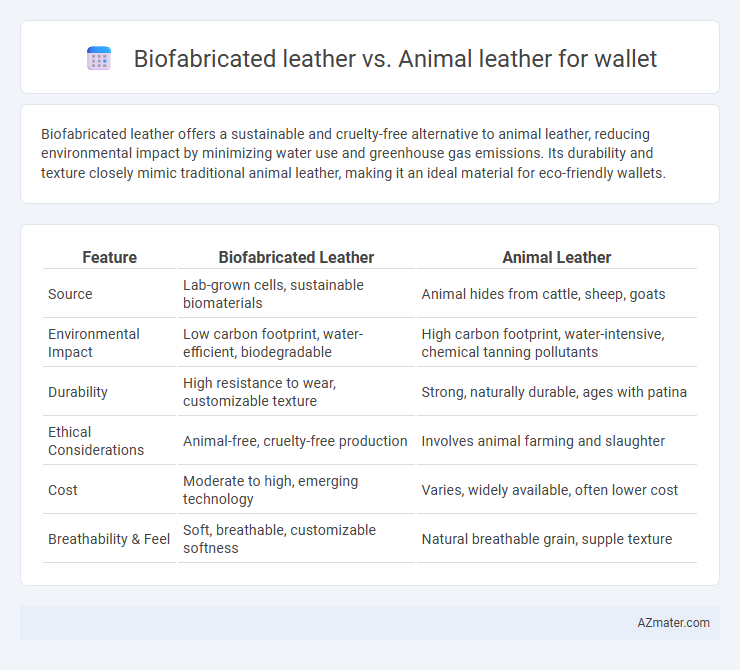Biofabricated leather offers a sustainable and cruelty-free alternative to animal leather, reducing environmental impact by minimizing water use and greenhouse gas emissions. Its durability and texture closely mimic traditional animal leather, making it an ideal material for eco-friendly wallets.
Table of Comparison
| Feature | Biofabricated Leather | Animal Leather |
|---|---|---|
| Source | Lab-grown cells, sustainable biomaterials | Animal hides from cattle, sheep, goats |
| Environmental Impact | Low carbon footprint, water-efficient, biodegradable | High carbon footprint, water-intensive, chemical tanning pollutants |
| Durability | High resistance to wear, customizable texture | Strong, naturally durable, ages with patina |
| Ethical Considerations | Animal-free, cruelty-free production | Involves animal farming and slaughter |
| Cost | Moderate to high, emerging technology | Varies, widely available, often lower cost |
| Breathability & Feel | Soft, breathable, customizable softness | Natural breathable grain, supple texture |
Introduction to Biofabricated and Animal Leather
Biofabricated leather is produced through sustainable biotechnological processes using cultured cells or plant-based materials, minimizing environmental impact and ethical concerns associated with traditional leather. Animal leather, derived from the tanning of cowhide or other animal skins, is valued for its durability, natural texture, and long-standing craftsmanship in wallet production. Choosing biofabricated leather offers a cruelty-free, eco-friendly alternative that aims to replicate the look and feel of conventional animal leather while reducing carbon footprint and resource consumption.
How Biofabricated Leather is Made
Biofabricated leather for wallets is produced through a sustainable process that involves cultivating collagen proteins derived from microorganisms or plant sources in controlled bioreactors, bypassing traditional animal farming. This lab-grown material mimics the fibrous structure and durability of animal leather while reducing environmental impacts such as greenhouse gas emissions and water consumption. The precision manufacturing allows customization of texture and thickness, making biofabricated leather a cutting-edge alternative to conventional leather in wallet production.
Animal Leather Production Process
Animal leather production involves the slaughter of livestock, primarily cattle, followed by a multi-step tanning process to preserve and enhance durability. This process includes curing, soaking, tanning with chemicals like chromium salts, and finishing treatments to achieve desired texture and appearance. High water consumption, chemical use, and greenhouse gas emissions characterize the environmental impact of animal leather production.
Environmental Impact: Biofabricated vs Animal Leather
Biofabricated leather significantly reduces environmental impact by eliminating the need for animal farming, which is a major source of greenhouse gas emissions, deforestation, and water consumption. Unlike traditional animal leather production, which relies on resource-intensive processes including livestock rearing and chemical tanning, biofabricated leather uses sustainable lab-grown materials, minimizing waste and pollution. This innovative alternative offers a cleaner, more eco-friendly option for wallet manufacturing with a smaller carbon footprint and enhanced resource efficiency.
Durability and Quality Comparison
Biofabricated leather demonstrates impressive durability by resisting wear, scratches, and moisture better than traditional animal leather, making it ideal for long-lasting wallets. Its consistent quality results from controlled production processes, eliminating the natural variations and imperfections often found in animal leather. Animal leather offers a timeless aesthetic and natural patina that enhances with use, but it may require more maintenance to preserve durability over time.
Aesthetic Differences: Look and Feel
Biofabricated leather offers a consistent, smooth texture with customizable finishes, often mimicking high-end animal leather's rich grain and patina over time. Animal leather naturally develops unique aging characteristics, including creases and color variations, contributing to its distinct, authentic aesthetic appeal. While biofabricated leather emphasizes uniformity and sustainability, animal leather delivers a traditional, tactile experience prized for its natural imperfections and durability.
Wallet Performance: Flexibility and Longevity
Biofabricated leather used in wallets offers superior flexibility due to its engineered microfiber structure, which mimics natural leather while maintaining consistent softness and resilience. Its longevity surpasses animal leather by resisting cracking, stretching, and wear from daily use and environmental factors like moisture and temperature fluctuations. Animal leather wallets, though durable, often require regular maintenance to preserve flexibility and prevent premature aging, whereas biofabricated alternatives provide long-lasting performance with minimal upkeep.
Ethical Considerations and Consumer Choices
Biofabricated leather offers a sustainable alternative to traditional animal leather, reducing animal cruelty and environmental harm associated with livestock farming. Ethical consumers increasingly prefer biofabricated options due to their lower carbon footprint and avoidance of animal exploitation. This shift in consumer choices drives innovation in cruelty-free materials, promoting more responsible and conscious fashion purchases.
Price Comparison and Market Availability
Biofabricated leather for wallets is often priced higher than traditional animal leather due to advanced production technologies and limited large-scale manufacturing. Animal leather wallets benefit from well-established supply chains, making them more widely available and affordable in the market. The growing demand for sustainable materials is gradually increasing the market presence and potentially lowering the cost of biofabricated leather products over time.
Future Trends in Wallet Materials
Biofabricated leather for wallets offers a sustainable alternative to traditional animal leather by utilizing lab-grown collagen fibers, reducing environmental impact and ethical concerns. Innovations in biofabrication enable customizable textures and enhanced durability, positioning it as a key material in the shift toward eco-friendly, high-performance accessories. As consumer demand for cruelty-free and sustainable products grows, biofabricated leather is expected to dominate future wallet materials, driven by advancements in biotechnology and circular manufacturing processes.

Infographic: Biofabricated leather vs Animal leather for Wallet
 azmater.com
azmater.com